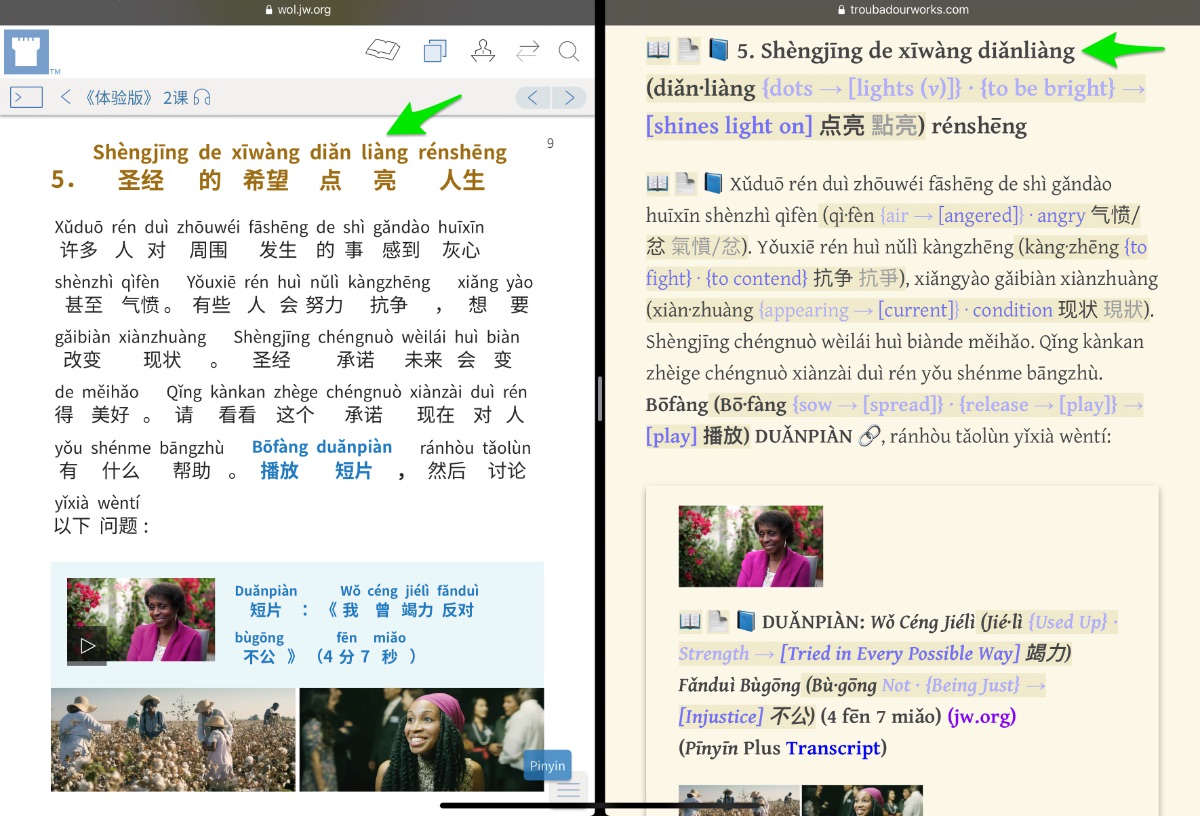diǎnliàng (diǎn·liàng {dot → [light (v); ignite]} · {to be bright} [→ [illuminate; shine light on]] 点亮 點亮) ← Tap/click to show/hide the “flashcard”
This week’s MEotW, “diǎnliàng (diǎn·liàng {dot → [light (v); ignite]} · {to be bright} [→ [illuminate; shine light on]] 点亮 點亮)”, is used to good effect in lesson 02 point 5 (WOL, Pīnyīn (Pīn·yīn {Piecing Together} · Sounds → [Pinyin] 拼音) Plus) of the Mandarin Enjoy Life Forever! (lffi) brochure (and of the Mandarin Enjoy Life Forever! (lff) book).

Translating the English text “The Bible’s hope can make a difference”, the Mandarin text means ‘The Bible’s hope shines a light on human life’.
What’s a Word?
Note that the Watchtower ONLINE LIBRARY currently renders the morphemes “”diǎn (dots → [lights (v)] 点 點)” and “liàng ({to be bright} 亮)” as two separate words, whereas the unofficial Pīnyīn (Pīn·yīn {Piecing Together} · Sounds → [Pinyin] 拼音) Plus resource renders them together as one word, as many past official Pīnyīn (Pīn·yīn {Piecing Together} · Sounds → [Pinyin] 拼音) publications would likely have done. Is one of these renderings “right” and the other “wrong”? Is one better and the other worse? How much does it matter?
These seemingly simple questions turn out to actually be not that simple to answer. Especially in languages like Mandarin that have historically been written using the Chinese characters writing system—a system that probably for traditional stylistic reasons neglects to clearly and conveniently put spaces between words like alphabetic writing systems generally do—there is not always a consensus regarding the answers to the questions of “What’s a word?” and “What morphemes should be put together as words?” As the Wikipedia article on “Word” says:
There still remains no consensus among linguists about the proper definition of “word” in a spoken language that is independent of its writing system, nor about the precise distinction between it and “morpheme”.[source] This issue is particularly debated for Chinese and other languages of East Asia,[source]
Standards and Conventions
Unlike the Chinese characters writing system, the Pīnyīn (Pīn·yīn {Piecing Together} · Sounds → [Pinyin] 拼音) alphabetic writing system does clearly and conveniently put spaces between words—such word separation is in fact a big advantage of Pīnyīn (Pīn·yīn {Piecing Together} · Sounds → [Pinyin] 拼音) compared to the Chinese characters writing system. However, the question of what constitutes a word that is to be separated from other words by spaces remains one that may be answered differently by different people.
The technical linguistic term that relates to such matters is orthography. The Wikipedia article on that provides this summary of what that means:
An orthography is a set of conventions for writing a language, including norms of spelling, hyphenation, capitalization, word breaks, emphasis, and punctuation.
One might wonder whether there are official rules and standards regarding Pīnyīn (Pīn·yīn {Piecing Together} · Sounds → [Pinyin] 拼音) orthography, and indeed there are. In fact, the PRC government has an official national standard for Pīnyīn (Pīn·yīn {Piecing Together} · Sounds → [Pinyin] 拼音) orthography, with the designation GB/T 16159-2012. (A convenient annotated web version (rendered in Simplified Chinese characters) has been made available here on the independent website Pīnyīn.info.)
What the letters “GB/T” stand for is significant. Wikipedia provides this summary:
GB stands for Guobiao (simplified Chinese: 国标; traditional Chinese: 國標; pinyin: Guóbiāo), Chinese for national standard.
Mandatory standards are prefixed “GB”. Recommended standards are prefixed “GB/T” (T from Chinese language 推荐; tuījiàn; ‘recommended’).
(The above summary is confirmed elsewhere on the web, e.g. here on legal analysis website Lexology.)
So, while the PRC’s GB/T 16159-2012 provides many basic rules regarding Pīnyīn (Pīn·yīn {Piecing Together} · Sounds → [Pinyin] 拼音) orthography, even within China it is not a mandatory standard—the “T” in “GB/T 16159-2012” indicates that even within China, it is at most a set of recommendations.
(An interesting contrast is the mandatory PRC standard GB 18030, which relates to software support for the PRC’s Chinese characters, both simplified and traditional, and which, for example, Microsoft makes its Windows software comply with.)
Regarding standards and conventions, even officially recommended ones, for things like language and writing, views and practices vary in different places, and at different times. For example, Chinese writing in the past didn’t have punctuation, and now it has punctuation largely modeled after European punctuation. (For reference: Chinese punctuation – Wikipedia, Q&A: When were punctuation marks first used? – HistoryExtra, history – When was punctuation introduced into Chinese? – Chinese Language Stack Exchange)
Even today, within the same time frame, there are differing views and practices regarding how things should be written. For example, in English, there are differing views and practices regarding British vs. American spellings, whether or not to use the Oxford (serial) comma, how titles should be capitalized, what should be italicized/bolded/underlined, etc.
When it comes to Pīnyīn (Pīn·yīn {Piecing Together} · Sounds → [Pinyin] 拼音), another factor to keep in mind is that due primarily to cultural prejudice, Pīnyīn (Pīn·yīn {Piecing Together} · Sounds → [Pinyin] 拼音) has simply not been used much overall, relatively speaking, especially as a full writing system on its own. So, it has not really gone through much of the process of receiving the widely agreed upon tweaks and refinements that a system typically receives as it gets tried out and put to extensive use by many people.
Verb-Complement Togetherness
Getting back to the MEotW “diǎnliàng (diǎn·liàng {dot → [light (v); ignite]} · {to be bright} [→ [illuminate; shine light on]] 点亮 點亮)”, the PRC national standard GB/T 16159-2012 recommends that, being made up of a single-syllable verb and its single-syllable complement, this expression should be written together. Recent official Pīnyīn (Pīn·yīn {Piecing Together} · Sounds → [Pinyin] 拼音) publications such as those on the Watchtower ONLINE LIBRARY often do not follow this recommendation regarding single-syllable verbs and their single-syllable complements, whereas older official Pīnyīn (Pīn·yīn {Piecing Together} · Sounds → [Pinyin] 拼音) publications did follow this recommendation, and as do the unofficial Pīnyīn (Pīn·yīn {Piecing Together} · Sounds → [Pinyin] 拼音) Plus resources.
On the other hand, the unofficial Pīnyīn (Pīn·yīn {Piecing Together} · Sounds → [Pinyin] 拼音) Plus resources join the official Pīnyīn (Pīn·yīn {Piecing Together} · Sounds → [Pinyin] 拼音) publications, old and new, in explicitly indicating tone sandhi for “bù (not 不)” and “yī (one 一)” (e.g., “búzài (bú·zài not · again; further; continuing; anymore 不再)” instead of the standard “bùzài (bù·zài not · again; further; continuing; anymore 不再)”) to make things easier for readers, even though this practice is not included in the GB/T 16159-2012 standard’s recommendations.
In the end, what matters most re how anything is written is not just what is officially recommended or what happens to be popular among changing, imperfect humans. Rather, what matters most is what really works best to accomplish the goal of writing: To communicate to readers. This is especially true when God-honouring and life-saving Bible truths need to be communicated. So, this blog and the other Pīnyīn (Pīn·yīn {Piecing Together} · Sounds → [Pinyin] 拼音) Plus resources will continue to seek to render Pīnyīn (Pīn·yīn {Piecing Together} · Sounds → [Pinyin] 拼音) in ways that maximize how clearly, easily, effectively, and appropriately it communicates with readers.
For convenience:
The direct link for the current generation Pīnyīn (Pīn·yīn {Piecing Together of} · Sounds → [Pinyin] 拼音) Plus resource for the Enjoy Life Forever! brochure is:
The direct link for the current generation Pīnyīn (Pīn·yīn {Piecing Together of} · Sounds → [Pinyin] 拼音) Plus resource for the Enjoy Life Forever! book is:
The short link for Chinese field language-learning links for the Enjoy Life Forever! brochure is:
The short link for Chinese field language-learning links for the Enjoy Life Forever! book is:
More Pīnyīn (Pīn·yīn {Piecing Together of} · Sounds → [Pinyin] 拼音) and Pīnyīn (Pīn·yīn {Piecing Together of} · Sounds → [Pinyin] 拼音) Plus web material based on the Mandarin Enjoy Life Forever! brochure and the Mandarin Enjoy Life Forever! book will be made available in the above-mentioned Pīnyīn (Pīn·yīn {Piecing Together of} · Sounds → [Pinyin] 拼音) Plus web resources as time allows.
